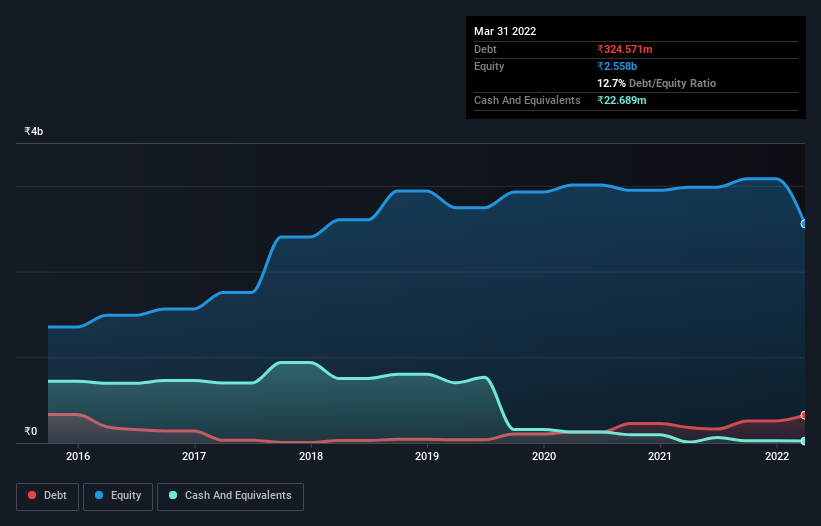- India
- /
- Electronic Equipment and Components
- /
- NSEI:CEREBRAINT
Here's Why Cerebra Integrated Technologies (NSE:CEREBRAINT) Can Manage Its Debt Responsibly
Howard Marks put it nicely when he said that, rather than worrying about share price volatility, 'The possibility of permanent loss is the risk I worry about... and every practical investor I know worries about.' When we think about how risky a company is, we always like to look at its use of debt, since debt overload can lead to ruin. Importantly, Cerebra Integrated Technologies Limited (NSE:CEREBRAINT) does carry debt. But should shareholders be worried about its use of debt?
When Is Debt A Problem?
Debt assists a business until the business has trouble paying it off, either with new capital or with free cash flow. If things get really bad, the lenders can take control of the business. However, a more usual (but still expensive) situation is where a company must dilute shareholders at a cheap share price simply to get debt under control. Of course, the upside of debt is that it often represents cheap capital, especially when it replaces dilution in a company with the ability to reinvest at high rates of return. When we examine debt levels, we first consider both cash and debt levels, together.
View our latest analysis for Cerebra Integrated Technologies
How Much Debt Does Cerebra Integrated Technologies Carry?
As you can see below, at the end of March 2022, Cerebra Integrated Technologies had ₹324.6m of debt, up from ₹181.5m a year ago. Click the image for more detail. On the flip side, it has ₹22.7m in cash leading to net debt of about ₹301.9m.

How Healthy Is Cerebra Integrated Technologies' Balance Sheet?
According to the last reported balance sheet, Cerebra Integrated Technologies had liabilities of ₹1.68b due within 12 months, and liabilities of ₹9.20m due beyond 12 months. Offsetting these obligations, it had cash of ₹22.7m as well as receivables valued at ₹1.89b due within 12 months. So it can boast ₹221.1m more liquid assets than total liabilities.
This short term liquidity is a sign that Cerebra Integrated Technologies could probably pay off its debt with ease, as its balance sheet is far from stretched.
In order to size up a company's debt relative to its earnings, we calculate its net debt divided by its earnings before interest, tax, depreciation, and amortization (EBITDA) and its earnings before interest and tax (EBIT) divided by its interest expense (its interest cover). Thus we consider debt relative to earnings both with and without depreciation and amortization expenses.
While Cerebra Integrated Technologies's low debt to EBITDA ratio of 0.71 suggests only modest use of debt, the fact that EBIT only covered the interest expense by 6.7 times last year does give us pause. So we'd recommend keeping a close eye on the impact financing costs are having on the business. Even more impressive was the fact that Cerebra Integrated Technologies grew its EBIT by 411% over twelve months. If maintained that growth will make the debt even more manageable in the years ahead. When analysing debt levels, the balance sheet is the obvious place to start. But it is Cerebra Integrated Technologies's earnings that will influence how the balance sheet holds up in the future. So if you're keen to discover more about its earnings, it might be worth checking out this graph of its long term earnings trend.
Finally, while the tax-man may adore accounting profits, lenders only accept cold hard cash. So we always check how much of that EBIT is translated into free cash flow. Over the last three years, Cerebra Integrated Technologies saw substantial negative free cash flow, in total. While investors are no doubt expecting a reversal of that situation in due course, it clearly does mean its use of debt is more risky.
Our View
Happily, Cerebra Integrated Technologies's impressive EBIT growth rate implies it has the upper hand on its debt. But the stark truth is that we are concerned by its conversion of EBIT to free cash flow. Looking at all the aforementioned factors together, it strikes us that Cerebra Integrated Technologies can handle its debt fairly comfortably. On the plus side, this leverage can boost shareholder returns, but the potential downside is more risk of loss, so it's worth monitoring the balance sheet. There's no doubt that we learn most about debt from the balance sheet. But ultimately, every company can contain risks that exist outside of the balance sheet. We've identified 2 warning signs with Cerebra Integrated Technologies (at least 1 which is potentially serious) , and understanding them should be part of your investment process.
Of course, if you're the type of investor who prefers buying stocks without the burden of debt, then don't hesitate to discover our exclusive list of net cash growth stocks, today.
New: AI Stock Screener & Alerts
Our new AI Stock Screener scans the market every day to uncover opportunities.
• Dividend Powerhouses (3%+ Yield)
• Undervalued Small Caps with Insider Buying
• High growth Tech and AI Companies
Or build your own from over 50 metrics.
Have feedback on this article? Concerned about the content? Get in touch with us directly. Alternatively, email editorial-team (at) simplywallst.com.
This article by Simply Wall St is general in nature. We provide commentary based on historical data and analyst forecasts only using an unbiased methodology and our articles are not intended to be financial advice. It does not constitute a recommendation to buy or sell any stock, and does not take account of your objectives, or your financial situation. We aim to bring you long-term focused analysis driven by fundamental data. Note that our analysis may not factor in the latest price-sensitive company announcements or qualitative material. Simply Wall St has no position in any stocks mentioned.
About NSEI:CEREBRAINT
Cerebra Integrated Technologies
Together with its subsidiary, trades in computer systems and peripherals in India.
Excellent balance sheet with slight risk.
Similar Companies
Market Insights
Community Narratives




